| Srl | Item |
| 1 |
ID:
172065
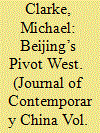

|
|
|
|
|
| Summary/Abstract |
This article seeks to contribute to ongoing debates about the causes and consequences of China’s Belt and Road Initiative (BRI). It argues via a neoclassical realist analysis that BRI can be seen as the product of the convergence of Aussenpolitik (foreign policy) and Innenpolitik (domestic politics) factors in China’s grand strategy, specifically enduring desires to balance against American primacy and to secure China’s frontier regions such as the Xinjiang Uyghur Autonomous Region (XUAR). The article concludes that the intersection of these objectives with the geopolitical logic of BRI (i.e. combating American primacy in the maritime domain of the Indo-Pacific through China-led Eurasian integration) provides an explanation for the timing and intensity of Beijing’s imposition of a pervasive ‘security state’ in Xinjiang.
|
|
|
|
|
|
|
|
|
|
|
|
|
|
|
|
| 2 |
ID:
172064


|
|
|
|
|
| Summary/Abstract |
This article examines the design, objectives, and implementation of the Belt Road Initiative (BRI) six years after its inception. It argues that although the BRI as a top-level design on which President Xi has staked his personal legacy is to serve China’s ambitious geostrategic and geo-economic interests, many developing countries have welcomed the BRI because of their desperate need in infrastructure construction. But the BRI’s popularity has exceeded the substance as China has yet to bridge many fault lines on the ground.
|
|
|
|
|
|
|
|
|
|
|
|
|
|
|
|
| 3 |
ID:
172073


|
|
|
|
|
| Summary/Abstract |
Vietnam’s perceptions of China are complex and have been shaped bycultural affinity, the memory of wars, and geopolitical considerationsthroughout history. The construction of their foreign discourse has led tothe empirical puzzle: what makes China and Vietnam, two of the emergingpowers in East Asia, stick together in the post-Cold War era? How to explaintheir diplomatic spats in maritime disputes? This article traces the development of the ‘16 Word Guideline,’ adopted by both communist parties in 1999 and highlighted the binding effect of assurance rhetoric. This discursive context presents great opportunities for them for regional integration. A framework of ‘coercive rhetoric’ captures China’s and Vietnam’s official statements to signal benign intentions toward their neighbors, and to constrain foreign behavior from both sides.
|
|
|
|
|
|
|
|
|
|
|
|
|
|
|
|
| 4 |
ID:
172072
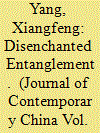

|
|
|
|
|
| Summary/Abstract |
Since the early 2000s, crises on the Korean Peninsula have prompted Chinese intellectuals and policy elites into fierce debates about Beijing’s North Korea policy. This study first provides an overview of those testy exchanges and then delves into the contestations about the bilateral relationship as well as the underlying assumptions beneath. On the question of identification, the Chinese are torn between characterizing North Korea as an ally or just as a neighbourly friend. On the question of whether its usefulness justifies continued Chinese support, the debates have revolved around North Korea as a geopolitical buffer, even though the strategic underpinnings are questionable. In both cases the mainstream views are fraught with contradictions and inconsistencies, which will certainly continue to hobble China’s North Korea policy.
|
|
|
|
|
|
|
|
|
|
|
|
|
|
|
|
| 5 |
ID:
172071
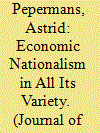

|
|
|
|
|
| Summary/Abstract |
This article shows how China became a global competitor in the railway- and construction equipment industry by using a combination of defensive and offensive mercantilist policy tools. While many scholars in IPE have recognized that economic state intervention is still commonplace, the literature focusing on economic nationalism has failed to grasp its multifaceted feature. By confusing economic nationalism with protectionism, the possibility of outward-looking measures within a mercantile strategy has been neglected. The research that does recognize the ability of states to combine global economic integration and continued market intervention, demonstrates an empirical bias towards strategic emerging industries and state-owned enterprises. This article includes the role of offensive economic policy measures as well as less strategic sectors and private- owned enterprises in China’s mercantile strategies.
|
|
|
|
|
|
|
|
|
|
|
|
|
|
|
|
| 6 |
ID:
172066
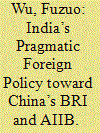

|
|
|
|
|
| Summary/Abstract |
India’s foreign policy toward China’s Belt and Road Initiative (BRI) and Asian Infrastructure Investment Bank (AIIB) is pragmatic. On the one hand, India has not only raised its apprehensions about the BRI but also taken measures to compete with it. On the other, India has joined China in the establishment of AIIB. The motivations behind India’s competition with China’s BRI stem from its concerns about the relative gains China might accrue through the BRI in its own backyards—South Asia and the Indian Ocean. In contrast, India’s full cooperation with China on AIIB has been driven by the absolute gains it can obtain through such cooperation, that is, not only considerable economic benefits but also an enhanced status in the international system.
|
|
|
|
|
|
|
|
|
|
|
|
|
|
|
|
| 7 |
ID:
172069


|
|
|
|
|
| Summary/Abstract |
In the reform era, the Chinese state often resorts to managed campaigns to implement important policies. This article examines how managed campaign influences the mode of bureaucratic operation in China. Avoiding a simplistic dichotomy between campaign mobilization and bureaucratic institutionalization, this study unpacks the Weberian bureaucratic concept and shows that some core dimensions of the model are compatible with managed campaign. While the pressure of mobilization tend to compromise functional differentiation and strict adherence to stable rules, they can reinforce other dimensions such as top-down control in a multilevel hierarchy and procedural integrity. The Chinese Communist Party (CCP) has configured the bureaucracy to serve its organizational and political needs, resulting in a mode of operation that partially conforms to the Western standard of public administration.
|
|
|
|
|
|
|
|
|
|
|
|
|
|
|
|
| 8 |
ID:
172067
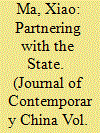

|
|
|
|
|
| Summary/Abstract |
How does the size of local state-owned sector affect the flow of foreign direct investment (FDI) to that region? Using an original county-level dataset for China’s Yangtze Delta Region, this article finds that counties inheriting a larger state-owned sector from the planned-economy era have attracted more FDI since the outset of the market reform. The article argues that early foreign investors tended to invest in locales with a robust state sector to build joint ventures with local state-owned firms, as doing so helped them satisfy state regulations and reduce various political and market risks. The legacies of the planned economy also shaped local states’ preferences, leading to persistent variations in local economic structure. An instrumental variable analysis suggests that the association is likely causal.
|
|
|
|
|
|
|
|
|
|
|
|
|
|
|
|
| 9 |
ID:
172070


|
|
|
|
|
| Summary/Abstract |
Past studies agree that the efficiency and effectiveness of policy experimentation is highly context dependent. This study examines how policy pilots are used as tools for implementing China’s energy transition and how this has produced mixed results. While pilots have effectively mobilized actors to rapidly expand renewable power generation, efforts to integrate renewable energy into power grids have been unsuccessful. The article shows that the central government uses policy pilots as an end in itself rather than as a means for future scale-up. Instead of using them as tools to bring about systemic change, the central government applies pilots as instruments of state signaling and coalition building. This promotes local protectionism and hinders coordinated efforts to achieve the envisioned sustainable energy transition.
|
|
|
|
|
|
|
|
|
|
|
|
|
|
|
|
| 10 |
ID:
172068


|
|
|
|
|
| Summary/Abstract |
Changing state–society relations in China have made it a challenge for the government to adopt unpopular policies that may incur blame and mass resistance. How can the Chinese regime adopt and implement unpopular policies when enforcement based on coercion is costly and undesirable? The article investigates property tax reform as a case to show how policy unpopularity and government strategies together resulted in a policy that failed to achieve any major policy goals. This study confirms China’s governance transformation compromises efficiency with broader public values and shows the limitedness of incremental reforms.
|
|
|
|
|
|
|
|
|
|
|
|
|
|
|
|